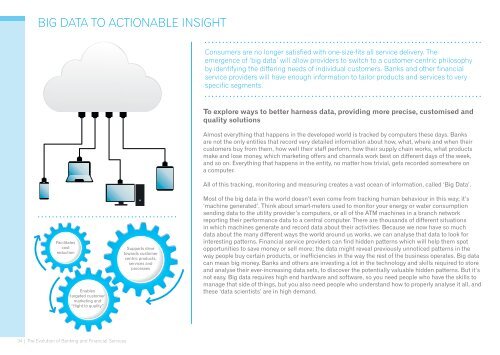EVOLUTION OF BANKING
Create successful ePaper yourself
Turn your PDF publications into a flip-book with our unique Google optimized e-Paper software.
BIG DATA TO ACTIONABLE INSIGHT<br />
Consumers are no longer satisfied with one-size-fits all service delivery. The<br />
emergence of ‘big data’ will allow providers to switch to a customer-centric philosophy<br />
by identifying the differing needs of individual customers. Banks and other financial<br />
service providers will have enough information to tailor products and services to very<br />
specific segments.<br />
To explore ways to better harness data, providing more precise, customised and<br />
quality solutions<br />
Almost everything that happens in the developed world is tracked by computers these days. Banks<br />
are not the only entities that record very detailed information about how, what, where and when their<br />
customers buy from them, how well their staff perform, how their supply chain works, what products<br />
make and lose money, which marketing offers and channels work best on different days of the week,<br />
and so on. Everything that happens in the entity, no matter how trivial, gets recorded somewhere on<br />
a computer.<br />
All of this tracking, monitoring and measuring creates a vast ocean of information, called ‘Big Data’.<br />
Facilitates<br />
cost<br />
reduction<br />
Enables<br />
targeted customer<br />
marketing and<br />
“flight to quality”<br />
Supports drive<br />
towards customer<br />
centric products,<br />
services and<br />
processes<br />
Most of the big data in the world doesn’t even come from tracking human behaviour in this way; it’s<br />
‘machine generated’. Think about smart-meters used to monitor your energy or water consumption<br />
sending data to the utility provider’s computers, or all of the ATM machines in a branch network<br />
reporting their performance data to a central computer. There are thousands of different situations<br />
in which machines generate and record data about their activities. Because we now have so much<br />
data about the many different ways the world around us works, we can analyse that data to look for<br />
interesting patterns. Financial service providers can find hidden patterns which will help them spot<br />
opportunities to save money or sell more; the data might reveal previously unnoticed patterns in the<br />
way people buy certain products, or inefficiencies in the way the rest of the business operates. Big data<br />
can mean big money. Banks and others are investing a lot in the technology and skills required to store<br />
and analyse their ever-increasing data sets, to discover the potentially valuable hidden patterns. But it’s<br />
not easy. Big data requires high end hardware and software, so you need people who have the skills to<br />
manage that side of things, but you also need people who understand how to properly analyse it all, and<br />
these ‘data scientists’ are in high demand.<br />
34 | The Evolution of Banking and Financial Services


